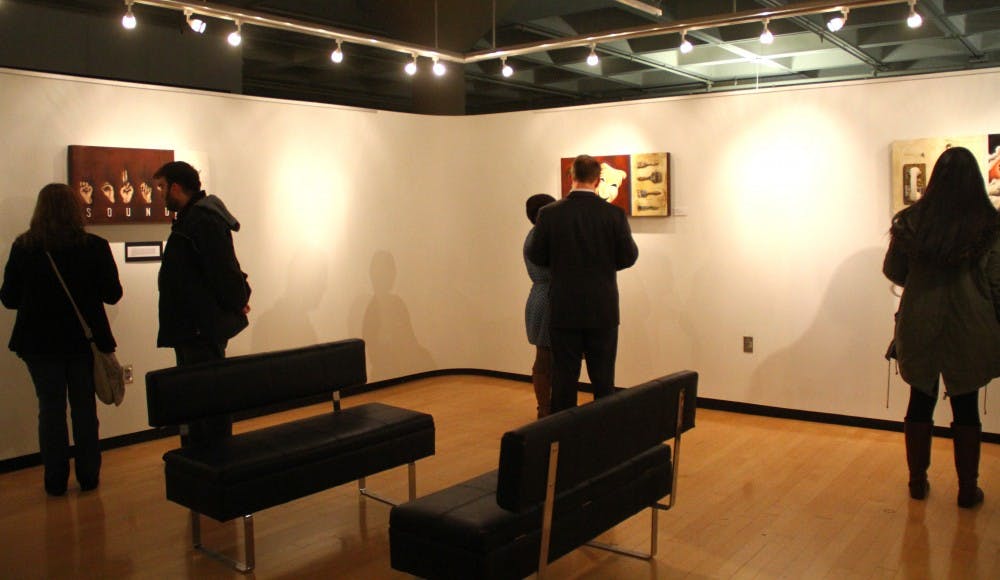Nestled in the Louise Jones Brown Gallery on the first floor, North Carolina-native Danielle Burch's omnibus of vivid artistry is on display. The collection as a whole is laden with fusions of deft brushwork and 3-dimensionsal projections. But it is much more than just uniquely aesthetic beauty: Burch's Synthesis: The Audio-Visual Connection relates raw ardor, insecurity and hope, all through the lens of one who has grown up with a hearing disability.
After stepping into the gallery, my eye was instantly pulled to a painting on my right. On one half, an old-school wired phone with its cord cut and frayed is latched onto a canvas; on the other half, a painted, towering cochlea is surrounded by a violent sea of clouds. The piece, entitled Why?, juxtaposes the idea of natural hearing in the cochlea––still defunct but continuing to cause trials––and the synthetic reception of sound mirrored in both the hearing aids and telephone.
However, more so, the piece and its namesake comment on the fact that the doctors at Johns Hopkins do not know why Burch is deaf other than the fact that her cochlea do not function properly.
At age five, Burch suddenly lost her hearing and her life was forever changed. She recalls, "I was too young to fully understand the magnitude of what happened, so it was a little easier for me to accept that I was deaf."
Since she lost her hearing a year before cochlear implant surgery was prevalent, Burch and her family learned sign language. To express their solidarity with Burch and their faith in God during this unfortunate turn of events, the first phrase they learned was "I love you"––the namesake and inspiration of one of the pieces in Synthesis. With such love and support, Burch and her family "never even saw a language barrier as a problem."
Nevertheless, some found Burch's disability to be debilitating.
As a child, Burch was very involved with theater and couldn't fathom a life "beyond the curtain." However, in 10th grade, her theater teacher told her that an actress could not be hindered by having to read lips and would begin to cover her mouth when she spoke to Burch. Frustrated by her teacher's treatment, Burch slowly lost the passion she had for theater. While upset at the time, retrospectively, Burch is grateful for her departure from theater because it allowed her to find her true love: art.
Burch heavily juxtaposes three-dimensional objects with paintings on her bilaterally organized canvases. While her imagery at times may seem to mesh together two dissimilar images, the power of the piece is found in what it represents––images and memories that forge a tale about moments of various sentiments in Burch's life.
Commenting on her artistic style, Burch noted, "There are abstract painting, non-objective geometric painting, realistic painting and assemblage techniques in each. I really like the idea of trompe l'oeil, which is French for 'fool the eye,' and try to make viewers look for the difference between a three-dimensional object and its painted version. This is especially evident in Tragedy to Comedy and Light (in the Darkness), with the paintbrushes and the candles, respectively."
At the end of touring the gallery, I noticed a painting with the imagery of a remarkably defined rose. The rest of canvas was just as thoughtful, but the vibrancy and definition of the flower was compelling. It also happens to be Burch's favorite piece because it is a testament to her faith in God that she believes carried her through the difficulties associated with being deaf.
The motif of faith is consistent in most of Burch's works. While the references to faith may be subtle to the average art-goer, Burch ensures that every piece “blatantly” presents her faith in some form. In fact, as part of her creative process, Burch often prays before attempting to begin her masterpieces.
Implantation, the piece including the vivid rose, is one the pieces that was divinely inspired and naturally came into fruition.
"I feel like I hardly did any work on it because it just unfolded itself... It's a depiction of my audiogram after hearing loss, compared to 'standard hearing,'” Burch explained. “The rose on the right-hand side represents my faith in Christ. Like a rose, trampled on the ground, He suffered more than I'll ever have to bear, so being deaf is nothing, really."
The DUU Visual Arts Committee, who brought Burch's work to Brown Gallery, selected her work because they were enamored by how she embraced her disability to create work that resonated with creativity and perseverance.
Committee co-chair Yuyi Li, online photo editor at The Chronicle, elaborated, "Through her paintings, the audience is able to see her struggles and hope in various circumstances. We hope that Duke students will be able to appreciate the art and gain a new perspective on how our senses affect our emotions and passions in life.”
Burch continues to persevere even after creating Synthesis. She is currently attending graduate school at the Rochester Institute of Technology in pursuit of an MFA.
"The way I see it, my deafness is not a PROBLEM; it's just part of who I am," said Burch.
Burch hopes that her work will also inspire others to follow their dreams. Despite all of the issues and shortcomings one might feel he or she has, Burch believes that if we persevere beyond all our doubts and insecurities––with a little support from the people we love––we can find great success in pursuing what we love
As Burch said, “I've never let being deaf stop me from doing anything, even when others thought deafness would be a hindrance."
Danielle Burch's "Synthesis," will be displayed in the Louise Jones Brown Gallery in the Bryan Center from Jan. 21 to Feb. 13.
Get The Chronicle straight to your inbox
Signup for our weekly newsletter. Cancel at any time.

